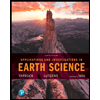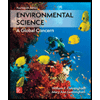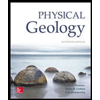
Fundamentals of Physical Geography
2nd Edition
ISBN: 9781133606536
Author: James Petersen
Publisher: CENGAGE L
expand_more
expand_more
format_list_bulleted
Question
Chapter 3, Problem 2PA
a)
To determine
The relationship that could establish the relation between latitude and solar angle as shown in the example, “a travel to 40°N latitude shows a solar angle of 50°”.
b)
To determine
A formula or set of instructions to generalize the relationship found in the previous question.
c)
To determine
The noon solar angle at 40°N on June 21 and on December 21.
Expert Solution & Answer
Want to see the full answer?
Check out a sample textbook solution
Chapter 3 Solutions
Fundamentals of Physical Geography
Ch. 3 - Prob. 1FQCh. 3 - Prob. 2FQCh. 3 - Prob. 4FQCh. 3 - Prob. 5FQCh. 3 - Prob. 6FQCh. 3 - Prob. 7FQCh. 3 - Prob. 8FQCh. 3 - Prob. 9FQCh. 3 - Prob. 11FQCh. 3 - Prob. 12FQ
Ch. 3 - Prob. 14FQCh. 3 - Prob. 15FQCh. 3 - Prob. 17FQCh. 3 - Prob. 18FQCh. 3 - Prob. 19FQCh. 3 - Prob. 20FQCh. 3 - Prob. 21FQCh. 3 - Prob. 22FQCh. 3 - Prob. 23FQCh. 3 - Prob. 25FQCh. 3 - Prob. 26FQCh. 3 - Prob. 27FQCh. 3 - Prob. 29FQCh. 3 - Prob. 1QRCh. 3 - Prob. 2QRCh. 3 - Prob. 3QRCh. 3 - Prob. 4QRCh. 3 - Prob. 5QRCh. 3 - Prob. 6QRCh. 3 - Prob. 7QRCh. 3 - Prob. 8QRCh. 3 - Prob. 9QRCh. 3 - Prob. 10QRCh. 3 - Prob. 1PACh. 3 - Prob. 2PACh. 3 - Prob. 3PA
Knowledge Booster
Recommended textbooks for you
 Applications and Investigations in Earth Science ...Earth ScienceISBN:9780134746241Author:Edward J. Tarbuck, Frederick K. Lutgens, Dennis G. TasaPublisher:PEARSON
Applications and Investigations in Earth Science ...Earth ScienceISBN:9780134746241Author:Edward J. Tarbuck, Frederick K. Lutgens, Dennis G. TasaPublisher:PEARSON Exercises for Weather & Climate (9th Edition)Earth ScienceISBN:9780134041360Author:Greg CarbonePublisher:PEARSON
Exercises for Weather & Climate (9th Edition)Earth ScienceISBN:9780134041360Author:Greg CarbonePublisher:PEARSON Environmental ScienceEarth ScienceISBN:9781260153125Author:William P Cunningham Prof., Mary Ann Cunningham ProfessorPublisher:McGraw-Hill Education
Environmental ScienceEarth ScienceISBN:9781260153125Author:William P Cunningham Prof., Mary Ann Cunningham ProfessorPublisher:McGraw-Hill Education Earth Science (15th Edition)Earth ScienceISBN:9780134543536Author:Edward J. Tarbuck, Frederick K. Lutgens, Dennis G. TasaPublisher:PEARSON
Earth Science (15th Edition)Earth ScienceISBN:9780134543536Author:Edward J. Tarbuck, Frederick K. Lutgens, Dennis G. TasaPublisher:PEARSON Environmental Science (MindTap Course List)Earth ScienceISBN:9781337569613Author:G. Tyler Miller, Scott SpoolmanPublisher:Cengage Learning
Environmental Science (MindTap Course List)Earth ScienceISBN:9781337569613Author:G. Tyler Miller, Scott SpoolmanPublisher:Cengage Learning Physical GeologyEarth ScienceISBN:9781259916823Author:Plummer, Charles C., CARLSON, Diane H., Hammersley, LisaPublisher:Mcgraw-hill Education,
Physical GeologyEarth ScienceISBN:9781259916823Author:Plummer, Charles C., CARLSON, Diane H., Hammersley, LisaPublisher:Mcgraw-hill Education,

Applications and Investigations in Earth Science ...
Earth Science
ISBN:9780134746241
Author:Edward J. Tarbuck, Frederick K. Lutgens, Dennis G. Tasa
Publisher:PEARSON

Exercises for Weather & Climate (9th Edition)
Earth Science
ISBN:9780134041360
Author:Greg Carbone
Publisher:PEARSON

Environmental Science
Earth Science
ISBN:9781260153125
Author:William P Cunningham Prof., Mary Ann Cunningham Professor
Publisher:McGraw-Hill Education

Earth Science (15th Edition)
Earth Science
ISBN:9780134543536
Author:Edward J. Tarbuck, Frederick K. Lutgens, Dennis G. Tasa
Publisher:PEARSON

Environmental Science (MindTap Course List)
Earth Science
ISBN:9781337569613
Author:G. Tyler Miller, Scott Spoolman
Publisher:Cengage Learning

Physical Geology
Earth Science
ISBN:9781259916823
Author:Plummer, Charles C., CARLSON, Diane H., Hammersley, Lisa
Publisher:Mcgraw-hill Education,